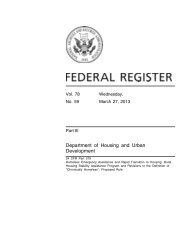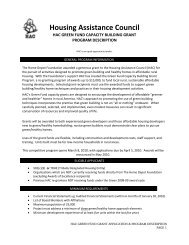Public Relations Guide for Rural Housing Organizations (manual
Public Relations Guide for Rural Housing Organizations (manual
Public Relations Guide for Rural Housing Organizations (manual
Create successful ePaper yourself
Turn your PDF publications into a flip-book with our unique Google optimized e-Paper software.
A headline that grabs attention is one that focuses on conditions, not yourorganization. For example, if part of the housing that your organization is providinginvolves new indoor plumbing, figure out how many gallons of water one womanwithout water has carried over the years.- Body. First comes the dateline – the place where the story originates and the date,“Marianna, Ark., June 13 – .”The first paragraph or “lead” is equivalent to the lead paragraph in a newspaper story.Tell the who, what, where, when, why, and how in 35 words or less, preferably in onesentence, but two sentences are okay.The first sentence is the most important. Without being misleading or omittingimportant in<strong>for</strong>mation, try to portray your news with words that will make the readerwant to read on. The first priority should be clarity of communication – do not get wildor fancy, and use clear language. Your first sentence will set the tone and determineyour release’s interest to the general public.The second paragraph should contain more in<strong>for</strong>mation about the news in two to threesentences. This would be a good place to expand on the particular event or instancethat precipitated your story.The second or third paragraph should contain a quote, with name and title, from animportant person involved in the project such as your executive director, president ofthe board, or a local notable person.Any further paragraphs should give more details and background. If the news media(newspapers, especially) are short of space or are using your piece as a filler on analready crowded page, it is the paragraphs toward the end of your release that will becut. Think of the paragraphs in terms of diminishing importance to the story, ones thatwould not be missed if they were left out.The final paragraph (which should be the same on every press release you send out)should be the one-paragraph description of your organization mentioned on page 13.- Bottom of page. End with one of the two traditional press release conclusions: “-30-“ or“###.” If your press release runs more than one page, put “– more –“ at the end ofeach page except the last. At the top of page 2 and beyond, put the page number and akeyword that represents the content of the release, “Page 2/Self-help, Marianna.” Onthe final page use one of the traditional ends.- Key items to check. Is the lead interesting? What impression will the reader be left with?Are concepts explained? Is the writing descriptive? Are the paragraphs a digestiblelength? Is the release free of grammatical, spelling, or other errors? Is it free of sexistor racist language?18 <strong>Public</strong> <strong>Relations</strong> <strong>Guide</strong>









